When the temperatures are dropping across the US and you’ve made it through the stress of the holidays, you may find yourself in desperate need of a vacay. But when it comes time to look at flights, and maybe trip packages, you may notice something when you start to type “D-o-m” into the search bar: instead of flights to the Dominican Republic, you see flights to Dominica. Maybe you’ve heard of the island, or maybe it’s your first time — or maybe you didn’t even know that Dominica and the Dominican Republic were two different countries.
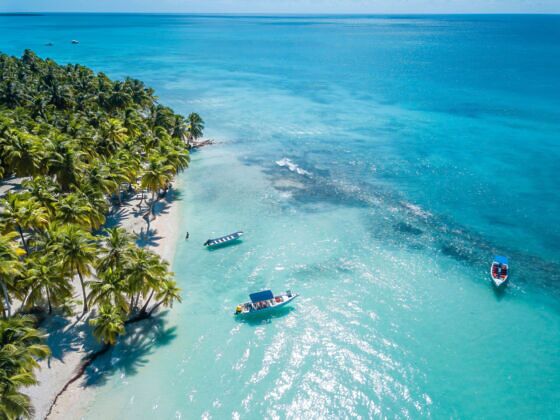

Dominica Vs. the Dominican Republic: Which Island Is Right for You?
So before you book your flight, you may want to learn some key differences between the countries of Dominica and the Republica Dominicana – a.k.a., the Dominican Republic, or DR.
Jump to:
- Culture of Dominica vs the DR
- Getting to Dominica or the Dominican Republic
- Things to do in both countries
- Hotels in the DR vs Dominica
- Food similarities and differences
- The best time to visit each country
- Costs of visiting Dominica vs the DR
- The verdict
History and culture of Dominica vs. the Dominica Republic
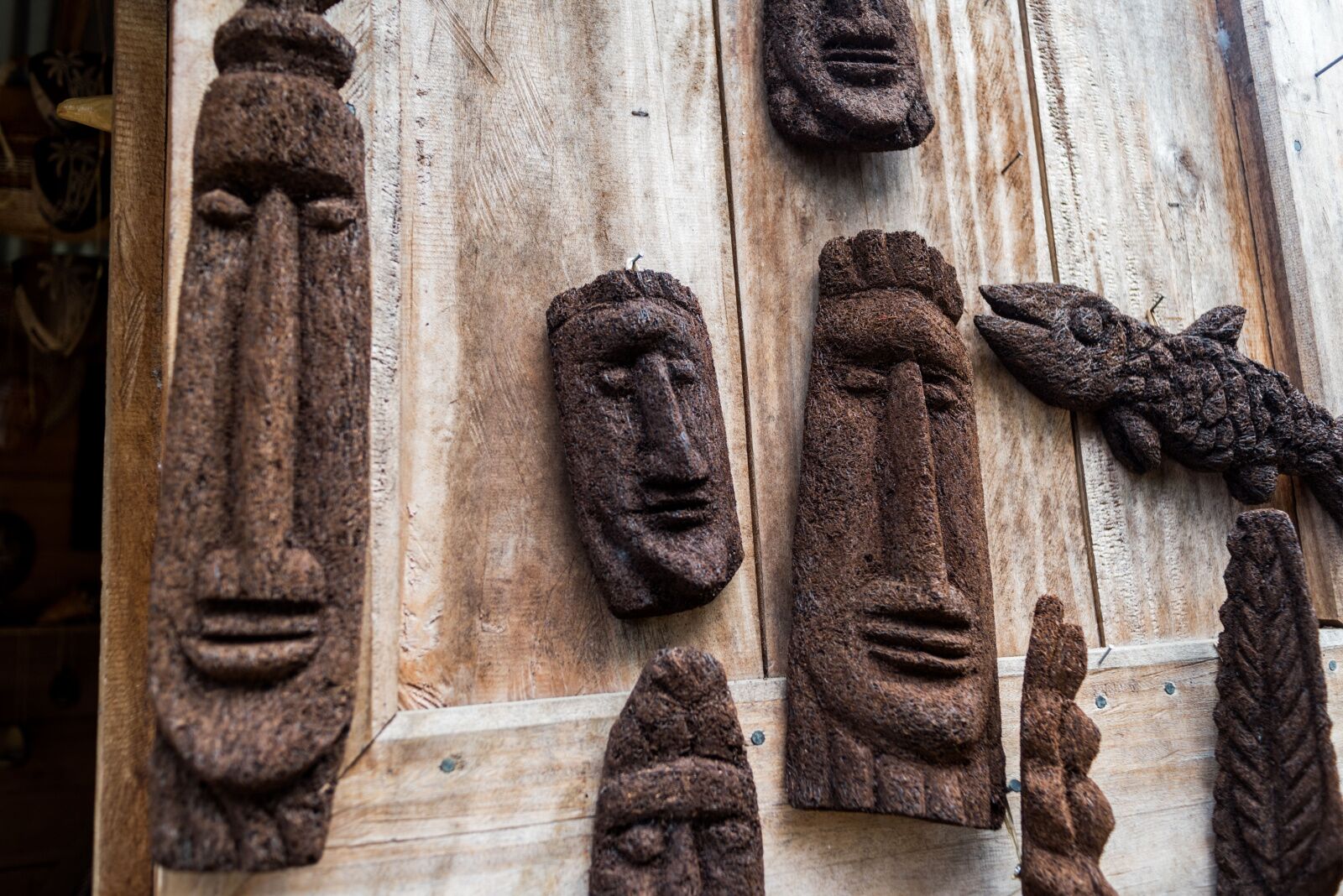
Wood-carved Kalinago masks from Dominica. Photo: Amery Butcher/Shutterstock
Dominica boasts the largest Indigenous community left in the Caribbean due to multiple successful attempts at fighting colonization. By 1763, European settlers had pushed the Kalinago Tribe primarily onto the island’s mountainous and steep eastern side, which was difficult for outsiders to navigate. After the British gained control, the Kalinago were allotted 232 acres. In 1903, that was increased to 3,700 acres.
To this day, the Kalinago influence is still felt in Dominica. Citizens whose heritage is a mix of African and Kalinago are called Caribs, and there’s even a local radio station that devotes time each day to a Kalinago history lesson and word of the day, taught by an elder. Many members of the tribe live well into their 100s, which makes the island an unofficial “blue zone.”
The island has only 76,000 residents, and most of the population is of African descent. There are also 3,000 Kalinago and quite a few mixed-race individuals. The majority of Dominicans speak English, and a few speak Patois. Kalinago has its own language, but it’s predominantly an English-speaking territory. The currency is the East Caribbean dollar, but USD is widely accepted.
The DR, on the other hand, has more than 11 million residents and is the most-visited Caribbean island for US travelers. The population in the Dominican Republic has a mix of Taino, African, and European roots. Most of the population speaks Spanish, but that won’t impact English speakers on the island in tourist destinations. Staff at resorts and tour companies are bilingual, and travelers should be fine getting by with just English. Most signage, museum displays, restaurants, and tours are also in English. The currency is the Dominican peso, but USD is also accepted.
Getting to Dominica vs. the DR
The main cities in Dominica are Roseau, Portsmouth, and Marigot; the latter is home to the island’s only international airport, Douglas-Charles Airport. By Caribbean standards, these may seem quite big, but Roseau only has 16,000 residents.
Dominica isn’t the easiest island to reach from the US and will require some flexibility in your schedule, since direct flights are only once a day from Miami, FL (or San Juan, PR), and missing your flight could be a headache. American Airlines is your only option for a direct flight. But assuming travel goes smoothly, you’ll fly over lush green terrain before landing on the airport’s new runway. Dominica’s airport is tiny, with a duty-free stand instead of a full store, but construction is underway for an international airport that can accommodate larger jets. The flight time from Miami is about 3.5 hours.
Getting to the Dominican Republic is generally easier (and cheaper). The DR has seven international airports, and flights to and from Santo Domingo and Punta Cana leave multiple times per day from most major US cities. Every major US airline flies there, with direct flights from nearly all eastern seaboard cities, plus towns in Texas, Colorado, and the Midwest. If you’re flying from the West Coast, you may have to make one connection. Punta Cana is a 2.5-hour flight from Miami.
Activities and things to do in the DR vs. Dominica
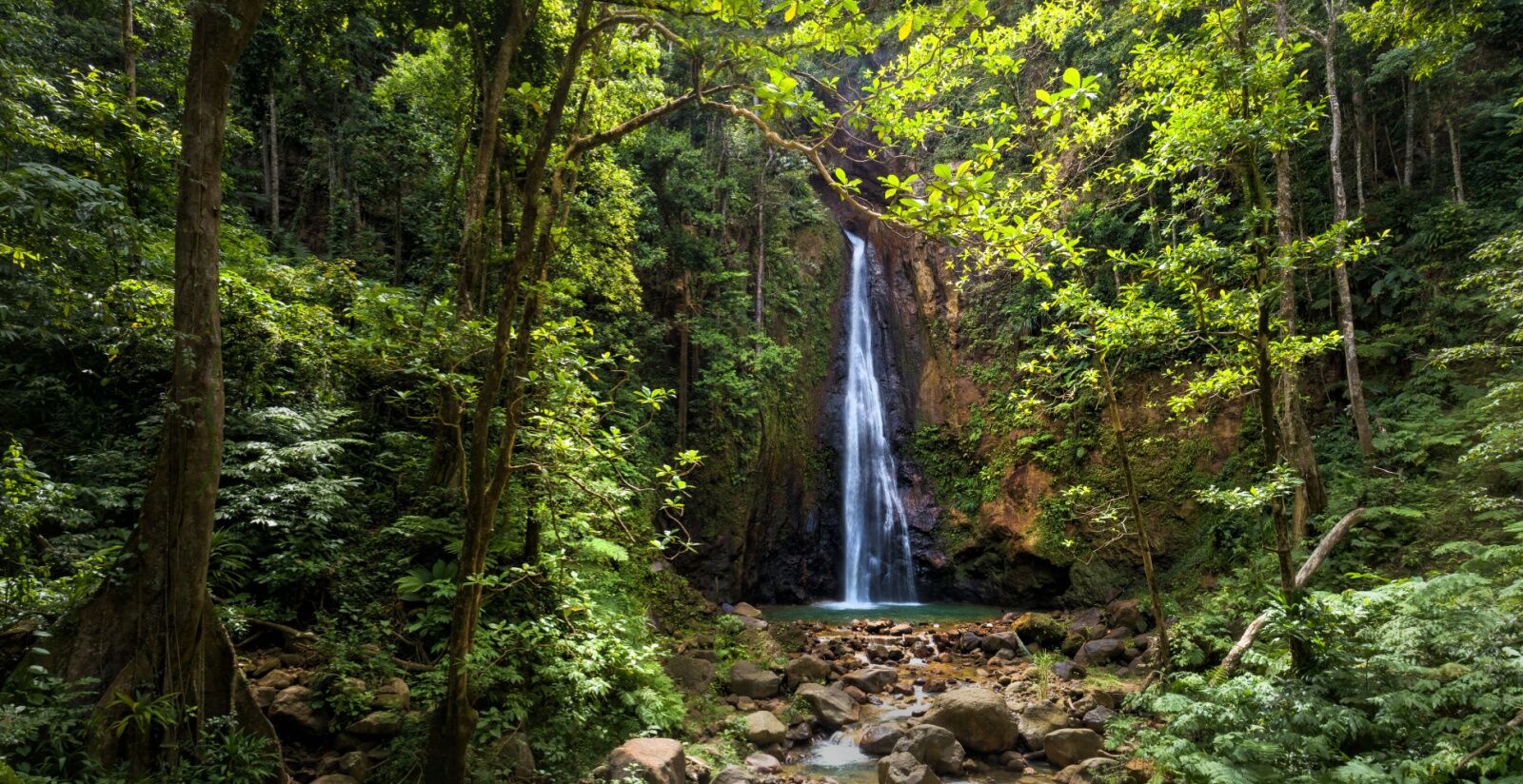
Syndicate Waterfalls in Dominica. Photo: Derek D. Galon/Shutterstock
Hotels across both countriess are used to booking activities for guests, so you don’t need to plan everything by yourself in either place. Many also offer their own activities for guests, like horseback riding along the beach at the Intercontinental on Dominica.
Dominica is plenty safe to explore on your own (if you can handle the rural, mountainous driving), but having a local show you around is how you fall in love with Dominica. The island is mostly undeveloped by Caribbean tourism standards, making it an attractive place for Hollywood films to shoot, such as “Pirates of the Caribbean: Dead Man’s Chest.” That movie made Titou Gorge famous, but the gorge has 65 rivers and 12 waterfalls to explore, so there’s plenty of room even on a crowded day. Many are close to one another and are easy to visit on one trip.
The island also has nine active volcanoes, making soaking in sulfuric hot springs popular among locals and visitors. Local tour guides can help make the destinations easier to find, and often are able to pass along discounts on entry fees to natural attractions.
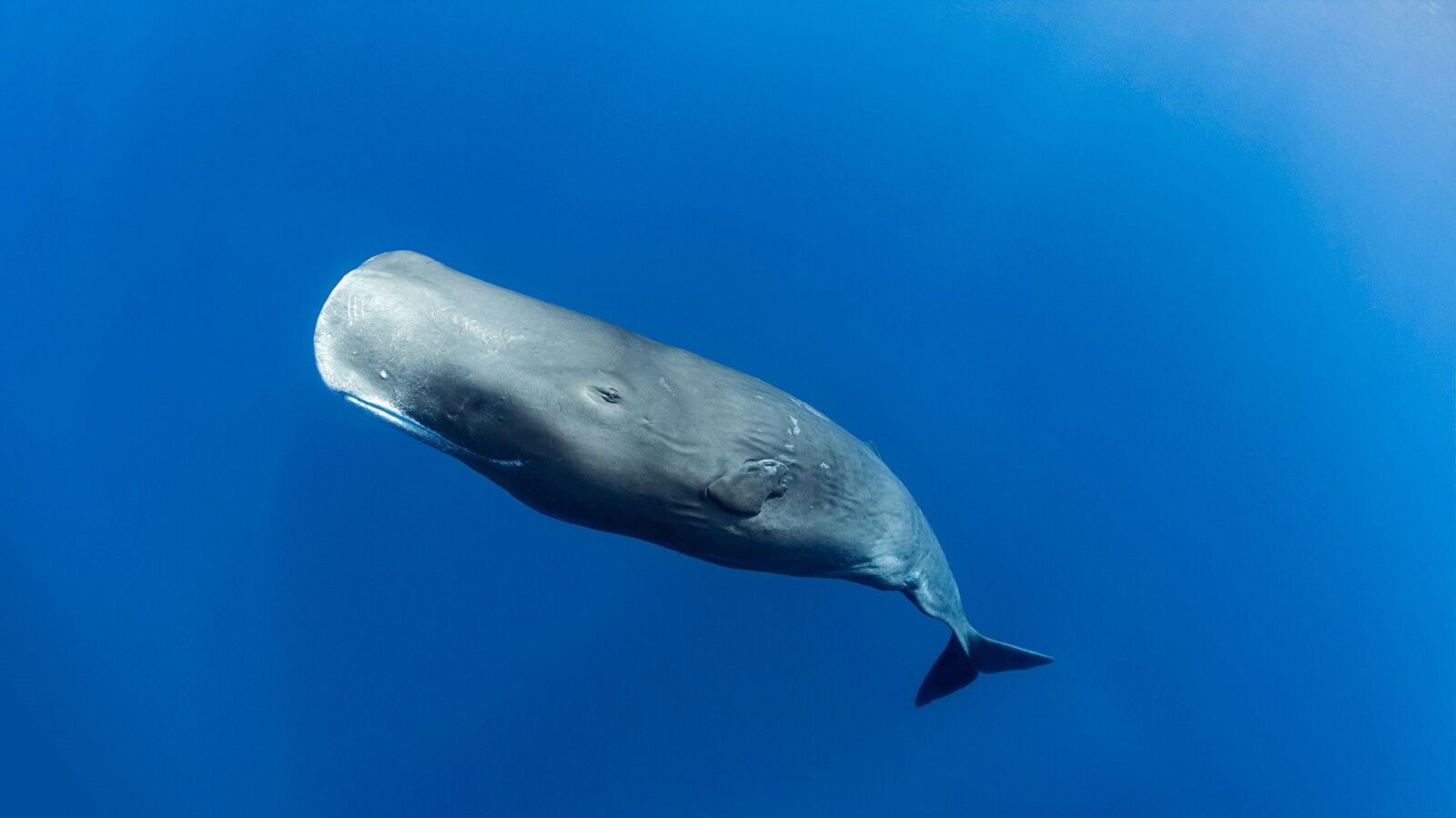
Photo: Animalgraphy/Shutterstock
The entire island is about 289 square miles and 29 miles long, but the roads are rough, and it could take hours to get to some places. Many people explore the areas around their resort or hotel, spending maybe one day on a long-haul excursion. The island is also a top scuba diving destination and a great place to see sperm whales.
In the Dominican Republic, cities like Santiago de Los Caballeros and Santo Domingo are known for their nightlife and party scenes, rather than their natural assets. You’re more likely to hear Latin American sounds like merengue and bachata music, as opposed to American tunes, and you’re more likely to mingle with locals who are friendly and love dancing. You may struggle a bit more if you don’t speak Spanish when venturing into residential areas and shops, and you may end up paying more money because of it.
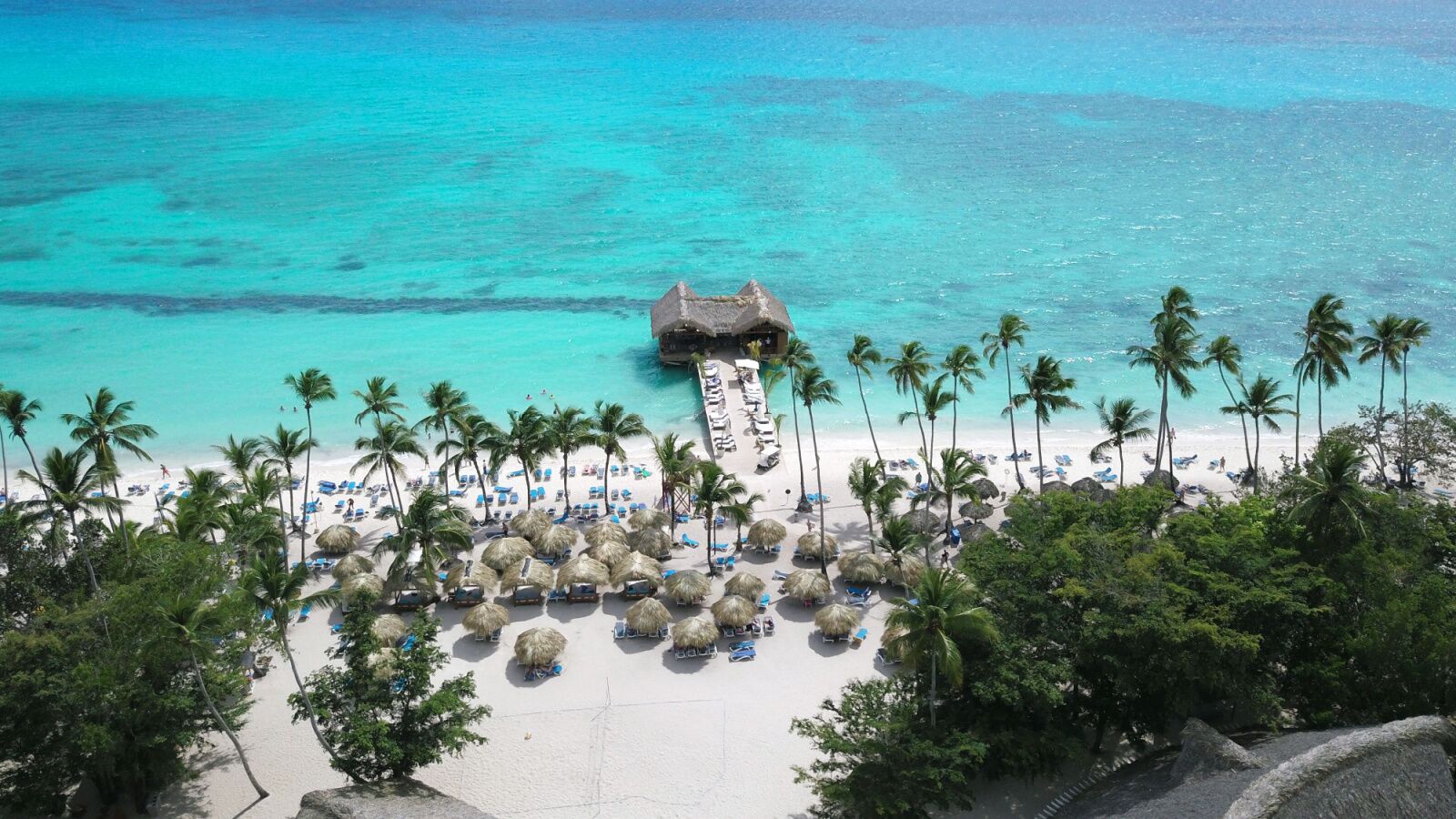
A beach in in La Romana, Dominican Republic. Photo: AeroPictures/Shutterstock
For watersports enthusiasts, Scape Park is worth the trip, with activities like cenote swimming and “splash lines” (zip lines over huge pools). The beaches of La Romana are the place to go if you’re into diving – or even if you’re not, since no trip to the island is complete without a trip to the beaches. Las Terrenas has a laid-back atmosphere and beautiful beaches and cenotes, and Playa los Platos also has a picturesque white sandy coast. Resorts can help plan excursions for zip lining, buggy rides, and water activities.
In a very general sense, the DR caters to soft adventure and activities that aren’t too physically taxing, while Dominica may be seen as a little more “wild.” That makes Dominica perhaps a better pick for adventure junkies, and the DR a better choice for groups with mixed comfort levels or older/younger travelers in their parties. But both have the jungle, mountain, and water adventures you’d expect of lush Caribbean islands.
Resorts and hotels across the Dominica vs. the Dominican Republic

Luxury resorts dot much of the Punta Cana shoreline. Photo: Pavel Prodan/Shutterstock
Dominica is on the verge of expansion. But for now, the island has only a small handful of five-star resorts and one chain: the Intercontinental on Douglas Bay, next to Cabrits National Park. The park is a popular hiking area known primarily for a trail to the remains of a historic fort. Secret Bay, also in Portsmouth, is a high-end eco-resort offering bungalows and villas, and Coulibri Ridge is a high-end blend of luxury and genuine sustainability. Outside of these three options, most visitors will stay in guest houses and small inns.
The Dominican Republic has quite a few more choices of hotels and resorts, both family-friendly and those for adults only. Considering that the DR covers more than 18,000 square miles, there really are resorts tailored to almost every type of traveler. While the island is known for the massive all-inclusive resorts around Punta Cana, there are also smaller beachfront properties and plenty of tucked-away eco-lodges and jungle stays.
Most visitors choose to stay in these types of accommodations – especially the all-inclusives – but cities like Santo Domingo and La Romanas have plenty of fantastic Airbnbs and guest houses. There can be safety concerns in some areas when wandering out on your own, so having a tour guide or using cabs or ride shares is generally safer than renting a car, and travelers should take precautions when walking outside of tourist areas or at night.
Food in the DR vs Dominica

Photo: Stefano Ember/Shutterstock
Despite the countries’ similar names, their cuisines exhibit notable differences.
In the Dominican Republic, the cuisine is a flavorful blend of Indigenous Taino, Spanish, African, and Middle Eastern influences. A staple in Dominican cuisine is mangu, made with mashed green plantains and served with sauteed red onions. Another popular and similar dish is mofongo, a savory mound of fried and mashed plantains mixed with garlic and seafood. It’s also popular in nearby islands like Puerto Rico.
On the other hand, Dominica’s cuisine reflects its natural bounty. Callaloo soup is a widely enjoyed dish in Dominica, made with dasheen leaves, okra, and coconut milk. Another one you’ll see on menus is bouyon, a hearty stew made with various meats, root vegetables, and green bananas, all locally grown.
But the countries do have a few culinary elements in common, as do many Caribbean islands. Rice and beans are staples, and seafood plays a significant role in both cuisines, with various fish, lobster, and conch dishes wildly available at street food stalls.
When to visit Dominica vs. the Dominican Republic
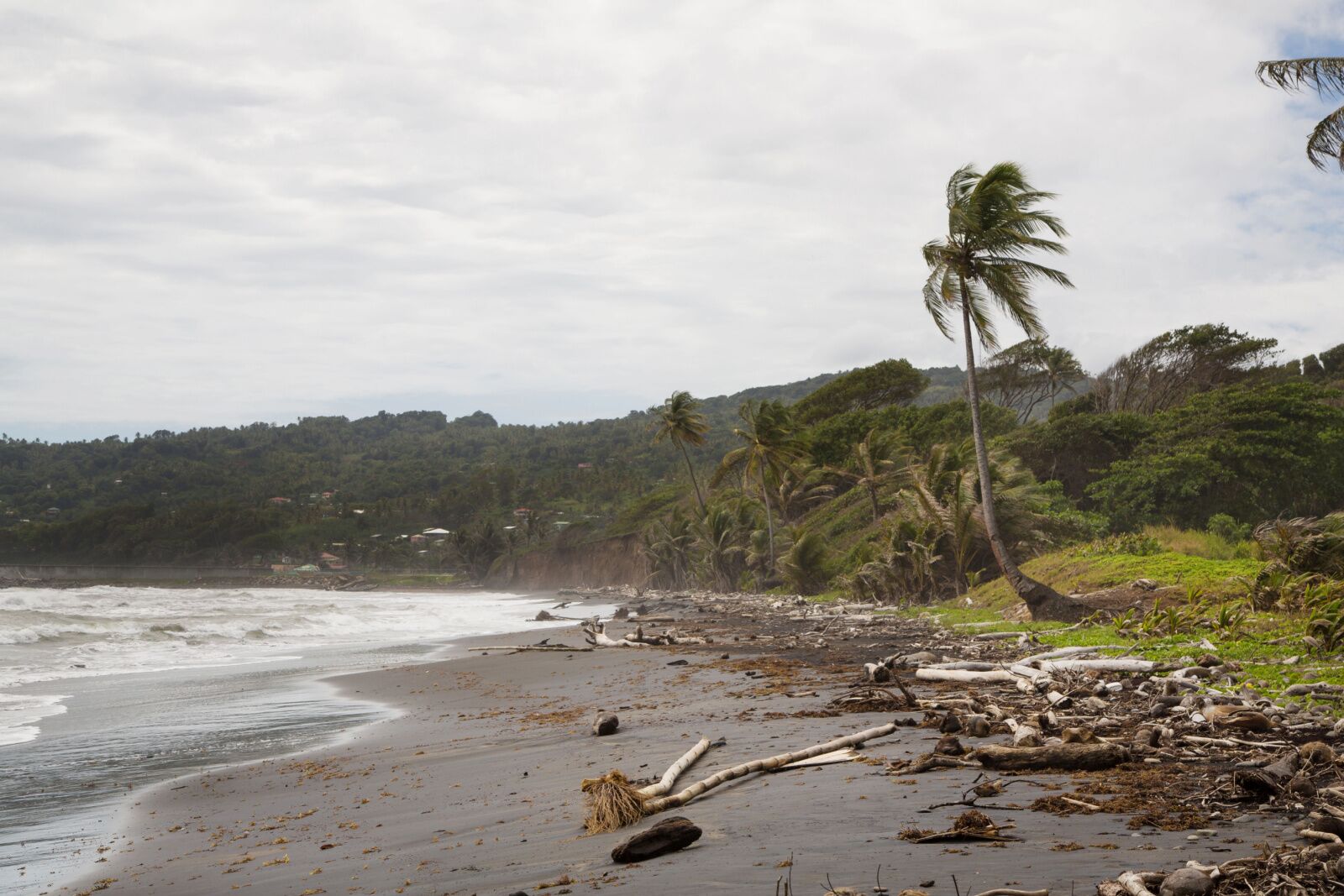
Both countries are subject to heavy rain and storms, especially during hurricane season. Photo: Jeanette Dietl/Shutterstock
The best times to visit the DR vs Dominica are pretty similar. Avoid hurricane season in both countries (roughly August to October). Winter and early spring in Dominica are the best times to visit to avoid the rainy season and take advantage of slightly cooler daytime temperatures. That said, the daytime highs are pretty similar year-round, ranging from the mid-80s to low 90s F.
The same time period is usually the best for visiting the DR as well, though it gets less hot than Dominica in the summer. July highs in the DR are usually in the high 80s F, while that’s somewhat chilly for Dominica. That’s because the DR is further northwest in the Caribbean than Dominica, giving it a slightly cooler and less humid climate. Slightly.
Costs of visiting the DR vs. Dominica

Large resorts with amenities like swim-up pool bars and beach activities are more affordable in the DR. Photo: Krivosheev Vitaly/Shutterstock
The Dominican Republic is generally considered a more affordable destination compared to Dominica. Flights to the Dominican Republic can often be more budget-friendly, especially if you’re flying to popular tourist destinations like Punta Cana or Santo Domingo. Hotel accommodations range from budget options to luxury resorts, providing a wide range of choices to suit different budgets, and enough competition to keep prices somewhat reasonable. Activities like tours, snorkeling, and sunset sails are usually less expensive than those in Dominica, primarily because there are so many options. The DR is also known for having some of the most affordable all-inclusive resorts in the Caribbean.
Smaller and less commercially developed Dominica generally has higher flight costs and hotel rates. Flights to Dominica are limited compared to most Caribbean destinations, and you’ll likely have a few connections. Accommodations in Dominica are fewer and further between, leading to higher prices for everything from guest houses to luxury hotels. That’s not to say that you can’t find affordable lodging, but you may have fewer choices.
The verdict

Photo: Derek D. Galon/Shutterstock
When it comes to Dominica vs. the Dominican Republic, it’s not so much which is better, but which offers the type of trip you want. If you have a sense of adventure, some schedule and budget flexibility, and a distaste for big hotels with lots of amenities, consider planning a trip to the eco-paradise of Dominica. If you have a group of travelers who want a mix of relaxing and high-energy activities, are more budget-conscious, or are looking for a resort where you can sip margaritas in the sun for a few days on the beach, the DR may be a better pick.
Of course, both resorts offer both experiences if you know where to go, so ultimately, there’s only one way to decide which is the best island for you: visit both.